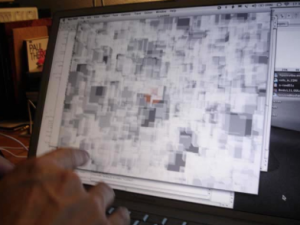Max clippings for Ableton Push
By Mark Egloff
Dowload: Media:MFL-Push_Package.zip Copy the “Ableton Push” folder into the Max 6.1 Packages folder.
Cycling 74 tutorial. https://cycling74.com/wiki/index.php?title=Push_Programming_Oct13_01
Max clippings for Ableton Push
By Mark Egloff
Dowload: Media:MFL-Push_Package.zip Copy the “Ableton Push” folder into the Max 6.1 Packages folder.
Cycling 74 tutorial. https://cycling74.com/wiki/index.php?title=Push_Programming_Oct13_01
The Live Object Model in Max for Live.
Several ways of working with Ableton Live parameters in a M4L patch. (This is an improved version of the patch we built in class) https://reactivemusic.net/?p=18401
The Live Object Model description: https://cycling74.com/docs/max5/refpages/m4l-ref/m4l_live_object_model.html
In the coming weeks we will build synthesizers and work with control surfaces in M4L
Build 3 or more M4L devices, including one of each of the following
Its ok to adapt and “improve” an existing device.
Please bring in your work in progress for next week and be prepared to demonstrate something. The entire assignment will not be due until March 31.
Introduction to getting, setting, and observing Live parameters with Max for Live.
https://github.com/tkzic/max-for-live-projects
folder: lom
patch: aaa-lom-examples
This example device shows several ways of working with Ableton Live parameters in a M4L patch. It can be a confusing process. And there are many different ways to accomplish the same result.
The examples here will use the LOM (Live Object Model) directly, and via builtin LiveAPI abstractions and choosers – available from the context menu that appears when you <ctrl> click inside of an open patcher window.
The snippet above shows how to continuously monitor Live’s tempo.
The snippet above shows how to set Live’s tempo.
The snippet above shows how to get Live’s tempo.
The snippet above shows how to start or stop the Live transport by calling functions.
The LiveAPI abstractions provide convenient shortcuts to working with Live parameters. Copy them into your patch by <ctrl> clicking inside an open (unlocked) patcher window – and selecting “Paste from -> LiveAPI abstractions”
The snippet above shows how to monitor whether the Live transport is running
The snippet above shows how to select the Master track
The LiveAPI choosers provide convenient shortcuts to selecting Live parameters from menu objects. Copy them into your patch by <ctrl> clicking inside an open (unlocked) patcher window – and selecting “Paste from -> LiveAPI choosers”
The snippet above shows how to remotely set the volume on the master track
“Boids is a bird flight and animal flock simulator. It is based on the same algorithm which was used in “Jurassic Park” for herding dinosaurs.”
Max external by Singer, Jasch, Sier and Smith. Tutorial by dude837
https://github.com/tkzic/max-projects
folder: boids
project: boids23
patch: main-tz.maxpat (slight modification to enable existing presets to work)

These are my versions of some of the patches. Not Cycling 74’s. If you find ‘official’ versions please let me know. The list isn’t complete. The simpler (beginning) patches are not included, but the interesting ones are.
https://github.com/tkzic/max-for-live-projects
folder: c74-video-tutorials
Sub-folders:
In Live, create new Max for Live devices, as instructed in the videos – and then copy and paste from these patches into your new patches.
Fractal geometry with Jitter.
By Peter Elsea
“Fractal geometry is the study of objects that have a property known as self- similarity – They are made up of smaller copies of the overall shape. One of the most popular is called the Sierpinski triangle”
The Max patches were developed (stolen) from Elsea’s lecture notes at http://peterelsea.com/Maxtuts_jitter/Fractals_in_Max.pdf. The first patch draws Sierpinski triangles. The second patch is generalized to circular shapes with N corners.
https://github.com/tkzic/max-projects
folder: fractals
patches:
You will need to download Elsea’s Lobjects abstractions and add the path to Max in Options | File Preferences: http://peterelsea.com/lobjects.html
Draw random colored dots on a 2d plane.
Dots are superimposed on a world map using the lcd object.
https://github.com/tkzic/max-projects
folder: random-oval-paint
patch: random-oval-paint.maxpat
additional files: worldMap.jpg
Load the patch and click the toggle in the upper left corner to begin drawing. Number boxes allow you change rate and dot size. Click the purple “clear” message to start over.
The matrix
(under construction)
State of the art:
Design a project that will be due at the mid-term. Send me an email next week describing the project.
Continue working through the Jitter tutorials 4-12
Design a prototype of a synthesizer that generates accompaniment for animated GIF’s
There will be no class next week February 10th
Andrew Benson’s Jitter recipes: https://cycling74.com/search-results/#gsc.tab=0&gsc.q=jitter%20recipes
Three part tutorial.
By Andrew Pask at Cycling 74
https://cycling74.com/2012/07/09/working-with-hardware-dmx-part-1/
https://cycling74.com/2012/09/11/working-with-hardware-dmx-part-2/
https://cycling74.com/2012/11/05/working-with-hardware-dmx-part-3/